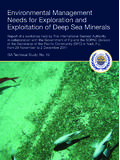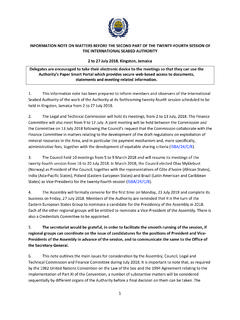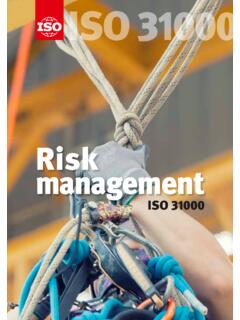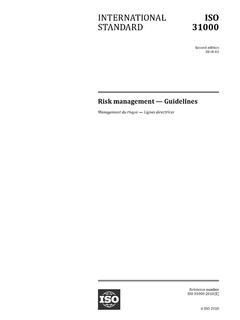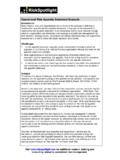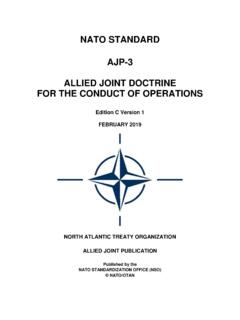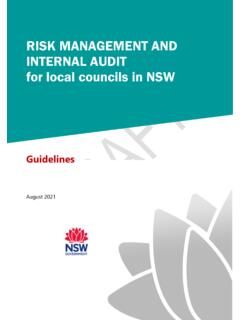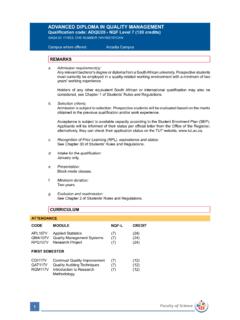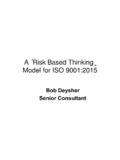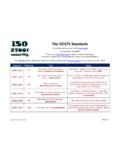Transcription of AS/NZS ISO 31000:2009 Risk management - Principles and ...
1 Joint Australian New Zealand International StandardRisk management Principles and guidelinesSuperseding AS / NZS 4360:2004AS / NZS ISO 31000 :2009AS / NZS ISO 31000 :2009 Copyright standards New Zealand * AS/NZS ISO 31000 :2009 This Joint Australian/New Zealand Standard was prepared by Joint Technical Committee OB-007, Risk management . It was approved on behalf of the Council of standards Australia on 6 November 2009 and on behalf of the Council of standards New Zealand on 16 October 2009. This Standard was published on 20 November 2009. The following are represented on Committee OB-007: Australian Computer Society Commerce Commission New Zealand Committee IT-012 Department of Education and Early Childhood Development Victoria Emergency management Australia Engineers Australia Environmental Risk management Authority New Zealand Financial Services Institute of Australia The Institute of Internal Auditors Australia Institution of Professional Engineers New Zealand International Association of Emergency Managers La Trobe University Law Society of New South Wales Massey University Minerals Council of Australia Ministry of Economic Development (New Zealand)
2 New Zealand Society for Risk management Risk management Institution of Australasia The University of New South Wales University of Canterbury New Zealand Keeping standards up-to-date standards are living documents which reflect progress in science, technology and systems. To maintain their currency, all standards are periodically reviewed, and new editions are published. Between editions, amendments may be issued. standards may also be withdrawn. It is important that readers assure themselves they are using a current Standard, which should include any amendments which may have been published since the Standard was purchased. Detailed information about joint Australian/New Zealand standards can be found by visiting the standards Web Shop at or standards New Zealand web site at and looking up the relevant Standard in the on-line catalogue.
3 For more frequent listings or notification of revisions, amendments and withdrawals, standards Australia and standards New Zealand offer a number of update options. For information about these services, users should contact their respective national standards organization. We also welcome suggestions for improvement in our standards , and especially encourage readers to notify us immediately of any apparent inaccuracies or ambiguities. Please address your comments to the Chief Executive of either standards Australia or standards New Zealand at the address shown on the title page. This Standard was issued in draft form for comment as DR 09063. *Employees of NIWA Ltd (331521) are licensed to temporarily download this document.
4 NIWA Ltd (331521) may print this document but not more than 10% of the documents subscribed to may be held in printed form at any one time. Copyright standards New Zealand *Online Subscription Service PDF Terms & Conditions An Authorised User may download a single copy of a document and retain that copy on their personalcomputer for a maximum of five working days for their internal purposes. At the expiry of five workingdays, the Document must be deleted from the Authorised User s computer. Each Authorised User may print one hard copy of any Document for their internal purposes. These copiesmay not be used to build up a hard copy reference collection. A reference collection is defined as acollection comprising more than 10% of the number of the Documents within the Authorised User ssubscription portfolio.
5 All hard copies of Documents must be destroyed on expiry of the subscriptionperiod. Copyright subsists in each of the Documents and the full title to that copyright is at all times retained byStandards New Zealand. Except as otherwise may be expressly permitted under the Copyright Act 1994 Authorised Users willundertake not to copy, modify, merge with other software or documents, or circulate electronically withoutsecuring the prior written permission of SNZ.. Under no circumstance may a Document, whether in electronic or hard copy form, be sold, or transferredto a third party. Under no circumstances may any Document be placed on a network of any sort without expresspermission of SNZ. Authorised Users may not modify, adapt, translate, reverse engineer, decompile, disassemble or createderivative works based on the Documents.
6 Right of access to the Subscription Service is personal to Authorised Users and can not be transferred,sold, leased, rented or loaned via a timesharing, service bureau or other arrangement. All Authorised User identification information, including logins and passwords, are to be kept secret andsecure. No Authorised User may attempt to damage, interfere or harm the SNZ website, or any network, or systemunderlying or connected to the Subscription Service. *Employees of NIWA Ltd (331521) are licensed to temporarily download this document. NIWA Ltd (331521) may print this document but not more than 10% of the documents subscribed to may be held in printed form at any one time. Copyright standards New Zealand *NOTES *Employees of NIWA Ltd (331521) are licensed to temporarily download this document.
7 NIWA Ltd (331521) may print this document but not more than 10% of the documents subscribed to may be held in printed form at any one time. Copyright standards New Zealand * AS/NZS ISO 31000 :2009 Australian/New Zealand Standard Risk management Principles and guidelines COPYRIGHT standards Australia/ standards New Zealand All rights are reserved. No part of this work may be reproduced or copied in any form or by any means, electronic or mechanical, including photocopying, without the written permission of the publisher. Jointly published by standards Australia, GPO Box 476, Sydney, NSW 2001 and standards New Zealand, Private Bag 2439, Wellington 6140. ISBN 978-1-86975-127-2 Originated as AS/NZS 4360:1995. Third edition 2004.
8 Revised and redesignated as AS/NZS ISO 31000 :2009. *Employees of NIWA Ltd (331521) are licensed to temporarily download this document. NIWA Ltd (331521) may print this document but not more than 10% of the documents subscribed to may be held in printed form at any one time. Copyright standards New Zealand *ii PREFACE This Standard was prepared by Joint standards Australia/ standards New Zealand Committee OB-007, Risk management to supersede AS/NZS 4360:2004, Risk management . When AS/NZS 4360:1999 was revised in 2004 (as part of a routine five yearly revision), it was decided by the Joint Australian/New Zealand Committee OB-007 that rather than undertake a similar revision in 2009, standards Australia and standards New Zealand would promote the development of an international standard on risk management which would then be adopted.
9 In 2005 the International Organization for Standardization (ISO) established a working group to develop the first international risk management standard using AS/NZS 4360:2004 as the first draft. The standard development process included extensive public consultation in Australia and New Zealand and resulted in the publication of ISO 31000 :2009. The main variations to AS/NZS 4360:2004, as outlined in the Introduction, are as follows: (a) Risk is now defined in terms of the effect of uncertainty on objectives. (b) The Principles that organizations must follow to achieve effective risk management have now been made explicit. (c) There is much greater emphasis and guidance on how risk management should be implemented and integrated into organizations through the creation and continuous improvement of a framework.
10 (d) An informative Annex describes the attributes of enhanced risk management and recognizes that while all organizations manage risk in some way and to some extent this may not always be optimal. The process described for managing risk is identical to that in AS/NZS 4360:2004. This Standard is identical with, and has been reproduced from ISO 31000 :2009, Risk management Principles and guidelines. Minor changes have been made to the Introduction to address the application of the Standard in Australia and New Zealand. As this Standard is reproduced from an International Standard, the following applies: (i) Its number does not appear on each page of text and its identity is shown only on the cover and title page. (ii) In the source text this International Standard should read this Australian/New Zealand Standard.
